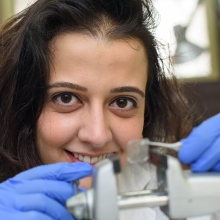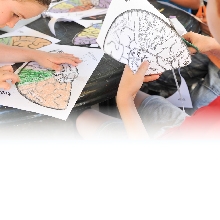When the campus becomes the lab
Prof. Tamir Klein’s super sensors are measuring the carbon intake of trees across the Weizmann campus
Features

The Klein lab has installed carbon sensors on 100 trees across 14 species throughout the Weizmann campus.
By Jennifer Racz
While studying the effect of elevated levels of carbon dioxide on forest trees at the University of Basel, Switzerland, Prof. Tamir Klein (then a postdoc) started to receive weekly emails from international companies. These companies wanted to know how they could measure the carbon uptake of trees and how long it would take them to absorb specific amounts of carbon. The inquirers were looking for ways to offset their carbon emissions in what was then the emerging market of carbon credits—a system designed by international policymakers to reduce greenhouse gas emissions by placing a ‘price’ on carbon dioxide and other pollutants. It seemed that no one really knew the answer to their questions.
Prof. Klein recalls, “I realized then that more than just teaching us about the ways trees function, studying the fate of CO2 uptake in trees could tell us about the roles that the trees could play in the rapidly growing climate crisis.” Thus began his quest to find the most effective and accurate way to measure carbon intake by trees.
Counting carbon
Trees absorb approximately 100 Gigatons (100 billion tons) of CO2 from the atmosphere every year—roughly the total amount of CO2 emissions generated by the US from 1990-2010—making them the most accessible and efficient natural solution to climate change, and a central player in the carbon market. Case in point, projects that involve planting or restoring forests can earn companies carbon credits based on the amount of carbon dioxide sequestered by the trees, providing financial incentives for aforestation and encouraging investment in forest conservation and restoration efforts.
Despite their critical role in carbon sequestration and incentive systems, existing methodologies to measure trees’ carbon-absorbing capabilities are crude and outdated, relying solely on tree diameter measurement once every five years or so. Other emerging applications use remote sensing methods, but these only offer rough estimates, and are therefore insufficient. In fact, erroneous monitoring and reporting are a proverbial thorn in the side of the forestry-related carbon market.
Tree-tech transfer
Drawing on their vast experience with carbon measurement systems, and encouraged by the team at Yeda Research and Development, Weizmann’s technology transfer arm, the Klein group did a series of calculations and published a paper on a previous method they used to measure carbon intake. The enormous response to the publication convinced them that they had indeed tapped into a need, and they set about to develop a new measurement system. Composed of a state-of-the-art sensor and an online database, their method involves placing a sensor under the tree bark where the carbon is transported from the leaves to all tree organs. The device then transmits a continuous stream of carbon-sequestration data to an online database.
With Yeda’s help, Prof. Klein and his team in the Department of Plant and Environmental Sciences’ Tree Lab are now working on a proof-of-concept using the campus as the ‘lab’ for their experiment, installing carbon sensors on 100 trees across 14 species throughout the Weizmann campus. Since August 2023, they have been continuously monitoring carbon uptake in these trees, resulting in a wealth of new information: present and past carbon uptake for different species; which species and individual trees outperform others, and which lag behind; and the total tree carbon intake of the entire campus grounds.
The group plans to use accumulated data from two to three years of continuous on-site monitoring as output for a computational model that can use climate data, along with metadata—e.g. tree and site characteristics and plot density—to simulate tree carbon uptake under different meteorological conditions, such as temperature, precipitation, and solar radiation. This information can be used to develop strategies for maximizing carbon sequestration in forests and plantations.
The Klein lab is also collaborating with the Oulanka Research Station in Finland, located on the edge of the Arctic Circle, to conduct a complementary study.
In addition to developing the technology and climate models, Prof. Klein submitted a patent application, currently pending, and has been working with Yeda and WIN (Weizmann Innovation Nest)— the start-up hub of the Institute—to explore the development of start-up companies based on this technology, as well as its broader impact on the Israeli climate-tech sector. His meticulous measurements of carbon uptake by trees have the potential to revolutionize the way trees are used to offset CO2 emissions and mitigate climate change.
Prof. Klein stresses the urgency of the matter, “Considering the grand challenge of climate change, and the unprecedented rate at which it is occurring, we simply cannot afford to wait."








